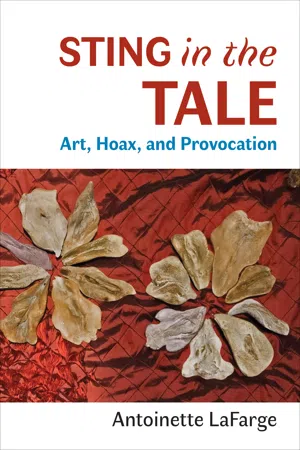
- English
- ePUB (mobile friendly)
- Available on iOS & Android
About this book
An illustrated survey of artist hoaxes, including impersonations, fabula, cryptoscience, and forgeries, researched and written by an expert "fictive-art" practitioner.
In her groundbreaking book, internationally recognized multimedia artist and writer Antoinette LaFarge reflects on the most urgent question of today: where does truth lie, and how is it verified? Encouraging readers to critically question the role art plays in shaping reality, Sting in the Tale: Art, Hoax, and Provocation defines a new genre of art that fabricates evidence to support a central fiction. Interweaving contemporary "fictive art" practice with a lineage of hoaxes and impostures dating from the 17th century, LaFarge offers the first comprehensive survey of this practice.
The shift from the early information age to our "infocalypse" era of rampant misinformation has made fictive art an especially radical form as it straddles the lines between fact, fiction, and wild imagination. Artists deploy a wide range of practices to substantiate their fictions, manufacturing artefacts, altering photographs, and posing as experts from many different fields. A fictive-art practitioner herself, LaFarge explores and underscores the myriad ways art can ground or destabilize one's lived reality, forcing us to question our subjective experience and our understanding of what counts as evidence.
Many examples of these curious and sometimes notorious fabrications are included - from nonexistent artists and peculiar museums to cryptoscientific objects like fake skeletons and staged archaeological evidence. From the intriguing Cottingley fairy photographs "captured" in 1917 by teenage sisters, to the Museum of Jurassic Technology; from the work of artists like Iris Häussler, Joan Fontcuberta, and Eva and Franco Mattes to the enigmatic encyclopedia known as the Codex Seraphinianus, fictive art continues to reframe assumptions made by its contemporaneous culture. With all the attendant consequences of mistrust, outrage, and rejection, fictive art practitioners both past and present play upon the fragile trust that establishes societies, underlining the crucial roles played by perception and doubt.
Frequently asked questions
- Essential is ideal for learners and professionals who enjoy exploring a wide range of subjects. Access the Essential Library with 800,000+ trusted titles and best-sellers across business, personal growth, and the humanities. Includes unlimited reading time and Standard Read Aloud voice.
- Complete: Perfect for advanced learners and researchers needing full, unrestricted access. Unlock 1.4M+ books across hundreds of subjects, including academic and specialized titles. The Complete Plan also includes advanced features like Premium Read Aloud and Research Assistant.
Please note we cannot support devices running on iOS 13 and Android 7 or earlier. Learn more about using the app.
Information
NOTES
Introduction
Chapter 1
Table of contents
- Cover
- Copyright
- Title Page
- Contents
- Dedication
- Foreword
- Introduction
- Defining Fictive Art
- Invented Artists
- Speculative History
- Institutions & Movements
- Fictive Science & Taxonomic Inventions
- Conclusion: Culture Jamming & Social Media
- Notes
- Bibliography
- Index
- Acknowledgments